Diabetic Foot Care: How to Take Care of Your Feet with Diabetes?
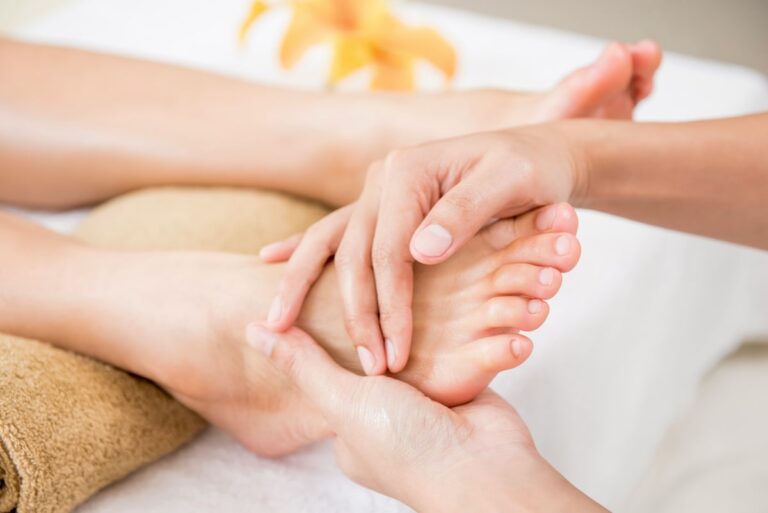
Diabetic foot care is essential and it’s in your hands. Whether you have type 1 or type 2 diabetes, high blood sugar levels put you at an increased risk of developing serious diabetic foot problems. In the USA only, around 100,000 adults undergo diabetes-related lower limb amputations every year.
Fortunately, you can stay away from foot complications if you follow a good diabetic foot care routine. Of course, keeping your blood sugars in range and your HbA1c below 7% is the best way to prevent foot problems from appearing. But following a flawless diabetic foot care routine, wearing appropriate footwear for diabetes and neuropathy, and getting your yearly diabetic foot exams can considerably help reduce the risks as well. Here’s all you need to know about diabetes foot care:
Why is diabetic foot care important?
People living with diabetes are at higher risks of developing serious foot conditions than the general population. When diabetes is not properly managed two main complications can arise: diabetic peripheral neuropathy (DPN) and peripheral artery disease (PAD). While the first one damages the nerves in the feet, the second one impedes proper blood circulation in the lower limbs. These two factors can lead to serious foot problems that diabetic foot care considerably helps prevent.
Diabetes damages the nerves in the feet
About 50% of people living with type 2 diabetes are affected by peripheral neuropathy. Over time, high blood glucose damages the nerves of the body’s extremities (feet and hands). Damaged nerves cause a variety of symptoms, ranging from mild to extremely debilitating. Diabetic neuropathy symptoms vary from one person to the other and include diabetic foot pain, cramps, tingling, prickling, burning sensations, numbness (loss of feeling), increased sensitivity to touch, and loss of balance.
Good foot care is essential for those diagnosed with diabetic peripheral neuropathy. It can considerably help slow down the progression of nerve damage, alleviate the pain, and prevent further complications such as infections, diabetic foot ulcers, and lower-limb amputations in the worst cases.
Diabetes reduces blood circulation in the feet
People with diabetes are also at an increased risk for peripheral artery disease. When you have PAD, a sticky plaque of cholesterol and fats builds up on the walls of your arteries. It can drastically slow down blood circulation, which leads to a lack of oxygen and nutrients delivered to the lower limbs and the feet. Ultimately, PAD increases the risks of foot infections, foot ulcers, and even foot gangrene.
Diabetic foot care can help boost blood circulation, decrease swollen feet, and prevent most complications caused by peripheral artery disease.

Diabetic Foot Care Guidelines
Diabetes is dangerous to your feet and poor diabetic foot care can lead to amputation of a toe, a foot, or even a leg. A tiny blister or a small cut could easily get infected without you noticing it before it’s too late. If you have type 1 or type 2 diabetes, you must observe a strict at-home daily routine to take care of your feet, even more so if you’ve been diagnosed with diabetic neuropathy or peripheral artery disease.
Following these diabetes foot care guidelines, you can prevent most serious complications.
1. Keep your HbA1c below 7%
What most impacts your feet’s health is your blood sugar level. Diabetes-related foot complications arise when diabetes is not properly managed and blood glucose levels are uncontrolled. Keeping your HbA1c below 7% and your blood sugars in the range is the very first rule to stay away from foot problems. Take your diabetes medications, follow a healthy lifestyle, balance your meals, exercise daily, and regularly ask for your doctor’s advice.
2. Get a diabetic foot care exam once a year
- Pain in your legs or feet
- Tingling, burning, prickling sensations
- Loss of sensation (numbness)
- Deformities in your feet or toes
- Loss of hair
- Cracked skin
- Change of your skin color
- Yellow toenails
- Fungus infections
- Blisters, sores, ulcers, or ingrown toenails
3. Inspect your feet daily
The possible decreased sensation (numbness) in your feet and legs caused by diabetic neuropathy can lead to cuts and wounds staying unnoticed. That’s why you must visually inspect each side of your feet and toes every day.
Check for redness, blisters, cuts, swelling, nail problems, bruises, calluses, or any other problems. Don’t forget to check in between your toes and under your feet. If you’re physically unable to do so, you can use a mirror. Never try to treat a foot problem by yourself when you have diabetes. If you notice anything unusual, call your doctor for advice.
4. Gently wash and dry your feet
Foot hygiene is fundamental when one wants to avoid diabetes-related foot problems. Wash your feet every day in lukewarm water. Do not use too cold or too hot water as both could damage your skin. Use a mild soap or a gentle foot wash. Gently pat or blot your feet to dry them even between your toes.
Related article: Can diabetics soak their feet?
5. Wear shoes for diabetes & neuropathy
Diabetic shoes are professionally and medically designed to help prevent and alleviate most common diabetic foot problems. They’re different from regular shoes. They’re non-binding to promote blood circulation and have protective interior linings to prevent blisters and irritations. Their extra-cushioning and enhanced foot support also help improve foot stability and overall balance. Neuropathy shoes are like diabetic shoes but even more protective. Consider one or the other depending on your needs.
Fitting is essential. Make sure your shoes aren’t too tight or too loose. Always inspect them before inserting your feet to be sure there are no pebbles or foreign objects that could harm your feet.
6. Consider socks for diabetics
Socks have their role to play in diabetes foot care too. Change them daily, and even more if your feet sweat a lot. Your socks should always be dry. It’s important to keep your feet warm, so wear socks at night if you have cold feet when sleeping. But be careful they’re not too tight and don’t compress your feet.
Consider wearing diabetic socks. They’re designed with a soft elastic or no elastic at all in order to avoid constricting your leg and blocking blood flow. They’re usually made in breathable, moisture-wicking, and anti-bacterial materials such as bamboo fibers or nano fibers to keep your feet in a dry and healthy environment. The best diabetic socks also provide extra padding and an entirely seamless construction to prevent blisters and irritations.
7. Moisturize your feet
High blood sugars may cause dehydration which can affect your skin too. Dry skin can peel, crackdown, or itch, causing further problems such as infections or foot ulcers. If the skin of your feet is dry, apply a moisturizing lotion after your daily wash. Do not apply between your toes as it could encourage a fungal infection.
Poor quality moisturizers and foot care products can be harmful. Not only won’t they be efficient, but they often contain chemicals that are too aggressive for diabetics’ fragile skin. Prefer diabetic creams and lotions that have been carefully formulated. Only use a moisturizer if you have dry skin. If your skin does not feel rough or dry, simply wash and dry your feet every day.
8. Keep your feet dry
Your feet’s skin needs to stay moist, but your feet need to stay dry! Fungal and bacterial infections tend to develop in moist areas. Be cautious not to let your feet stay wet for too long after being under the rain or the snow. Use waterproof shoes when necessary.
If you tend to have sweaty feet, choose appropriate socks and shoes with moisture-wicking and anti-bacterial materials. Change your socks whenever they are wet.
9. Keep your feet warm
Due to poorer blood circulation, people with diabetes often have cold feet. Cold increases skin irritation, dryness, and foot problems in general. Always keep your feet warm (but not too warm so they don’t sweat too much!). In the winter, choose warmer socks made with quality materials such as Merino wool, Alpaca wools, or thick bamboo fibers for example. Wear your socks at night if needed.
10. Trim your toenails properly
Bad toenail trimming can lead to foot problems such as ingrown toenails that easily get infected. You should check your toenails at least once a week.
- Prefer trimming them after your bath or shower when they are softer and suppler.
- Use a nail clipper and cut straight across. Do not round off the corners nor trim on the sides.
- Do not cut the toenails too short. Leave about 1 millimeter of white showing at the tip of your nail.
- Do not push cuticles back. They help prevent bacteria and infection from going into the nail matrix.
- After clipping, smooth your toenails with a nail file to prevent jagged edges.
Here’s a useful Podiatrist’s video guide on how to properly cut your toenails:
Diabetic Foot Care: What NOT to do!
- Never walk barefoot, especially on hot pavement or sandy beaches.
- Do not use heating pads, hot water bottles, or electric blankets on your feet.
- Do not attempt to treat foot problems yourself. Always see your doctor first.
- Never remove corns or calluses without your doctor’s advice.
- Do not “pop” blisters. Their upper skin helps prevent infections.
- Never use antiseptic solutions on your feet without your doctor’s advice. They can burn your skin.
- Do not soak your feet into products that have not been approved by your doctor.
- Avoid sitting with your legs crossed for long periods of time. I can reduce blood flow.
Best Diabetes Foot Care Products
A good diabetes foot care is so essential that it’s often worth investing in some specialized products. Diabetic foot creams, powders, socks, shoes, insoles, electric foot massagers, circulation boosters, TENS units for pain, essential oils… There are plenty of things out there that can really improve your feet’ health and help you manage the pain and symptoms caused by diabetes.
1. GoldBond diabetic foot care cream
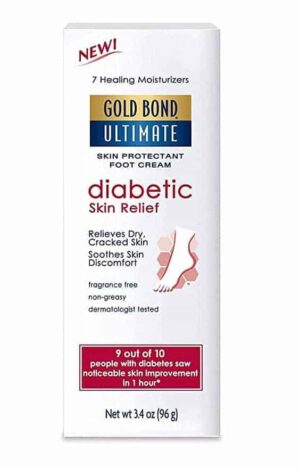
Gold Bond Diabetic foot cream is #1 on the list of the 10 best diabetic lotions and foot creams in 2022. It’s a great moisturizer for diabetics whose feet’ skin tends to be dry and crack. It’s specially formulated for fragile skins and does not contain any fragrance, parabens, allergens, or irritants. Besides being a great moisturizer, this diabetic foot care product contains aloe vera extract which is a great soother for diabetes-related skin problems such as irritations, rashes, and itchy skin.
2. Zatural CBD pain cream for diabetic neuropathy
Best for diabetic neuropathy foot pain

Zatural CBD Hot Cream is the most effective pain-relief cream for neuropathy. It’s infused with 2000 mg of organic broad-spectrum CBD oil, one of the newest natural painkillers found to work great on nerve pain. Besides, Zatural hot cream is packed with essential oils and plant extracts including Helichrysum flower oil (helps regenerate damaged nerves), Basil oil (a good nerve tonic), and Peppermint oil (helps boost blood circulation). It also contains Menthol crystals for a cooling effect that helps ease nerve pain, as well as Chamomile and Aloe Vera for their incredible soothing and calming properties.
3. GoldBond diabetic foot care powder
Best for sweaty feet & itchy feet
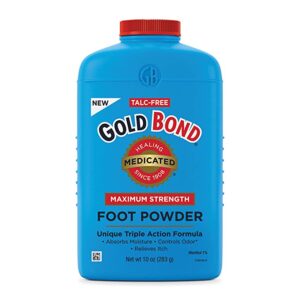
If you have sweaty feet or itchy skin, diabetic foot care powders might be more suited than foot creams or ointments. Keeping your feet dry is essential when living with diabetes. GoldBond’s talc-free medicated foot care powder helps control sweat and odors. It contains 1% menthol to cool the feet and relieve itching. It’s a great and cheap product that’s well-appreciated by its customers!
4. Padded diabetic socks with bamboo fibers
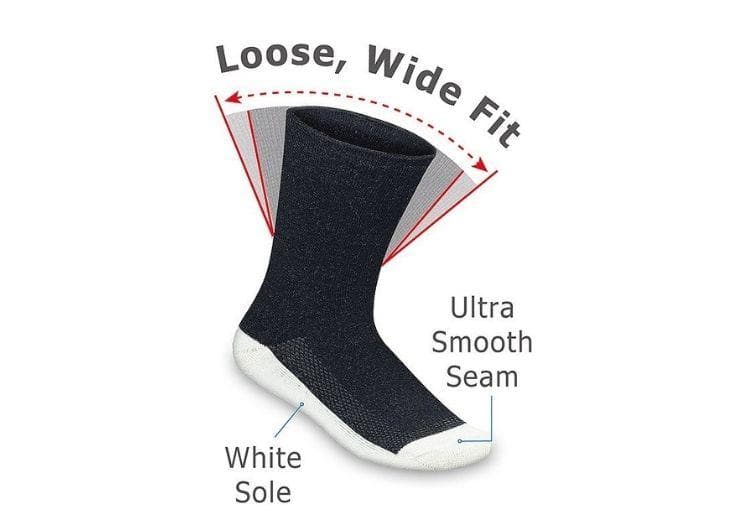
These padded-sole diabetic socks from Orthofeet would be a great addition to any diabetic’s foot care gear, and even more so for those with circulatory problems or swollen feet. They combine a non-binding seamless design that helps boost blood circulation and decrease swelling, with a top-notch bamboo fibers cushioned moisture-wicking and anti-bacterial yarn that keeps your feet in a dry and healthy environment.
Related article: The 10 best diabetic socks for women in 2022
Related article: The 20 best diabetic socks for men in 2022
5. Orthofeet diabetic shoes
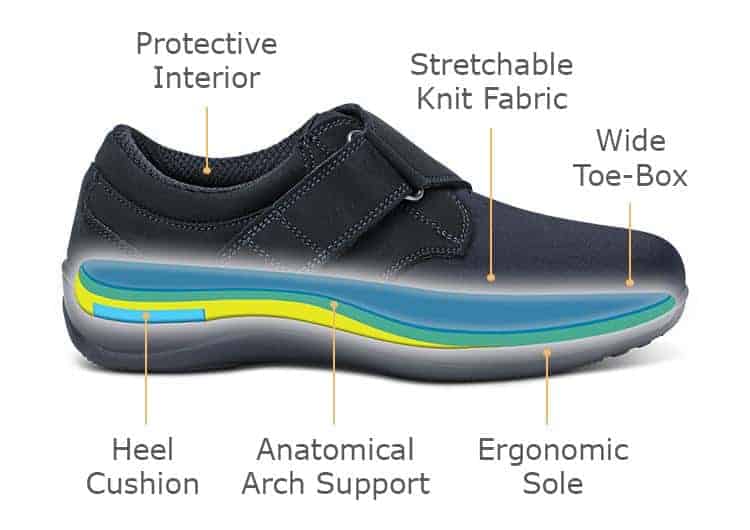
Orthofeet is the orthopedic footwear company most often recommended by podiatrists to their patients suffering from diabetes and neuropathy foot problems. The company has designed no less than 50 diabetic shoe styles for men and for women, including casual shoes, sneakers, boots, sandals, dress shoes, and slippers. All Orthofeet shoes have adjustable designs, seam-free interior linings, removable premium orthotics, great arch support, extra cushioning, roomy toe boxes, and extended width options. When you buy on their website, you get a 60-days wear test and a 100% money-back guarantee.
If you don’t find your dream shoes with Orthofeet, get more choice here: The 10 Best diabetic shoes to protect your feet in 2022!
6. Apex unisex Basis slip-on slippers
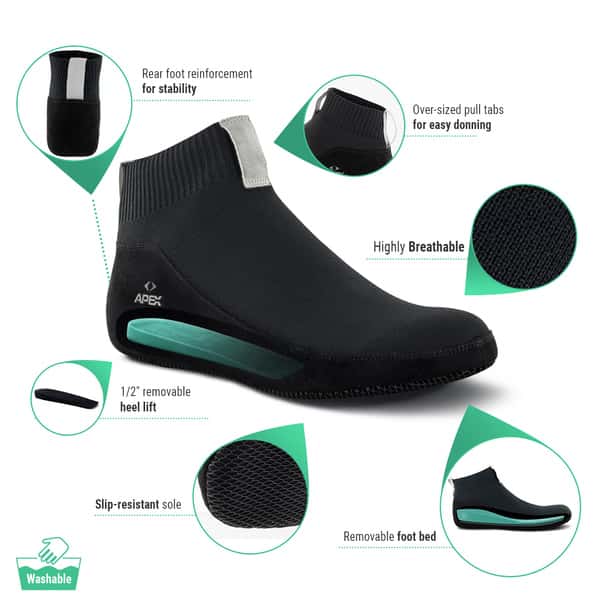
Think about how many hours a day you have your slippers on? Diabetic slippers are probably one of the most valuable diabetic foot care products. Apex Basis slip-on house shoes are the absolute best for diabetics who suffer from nerve pain, edema, or achy feet in general. They have a unique sock-like “no-feel” design that puts no pressure points on your feet but still provides enough support and stability.
7. Diabetic insoles
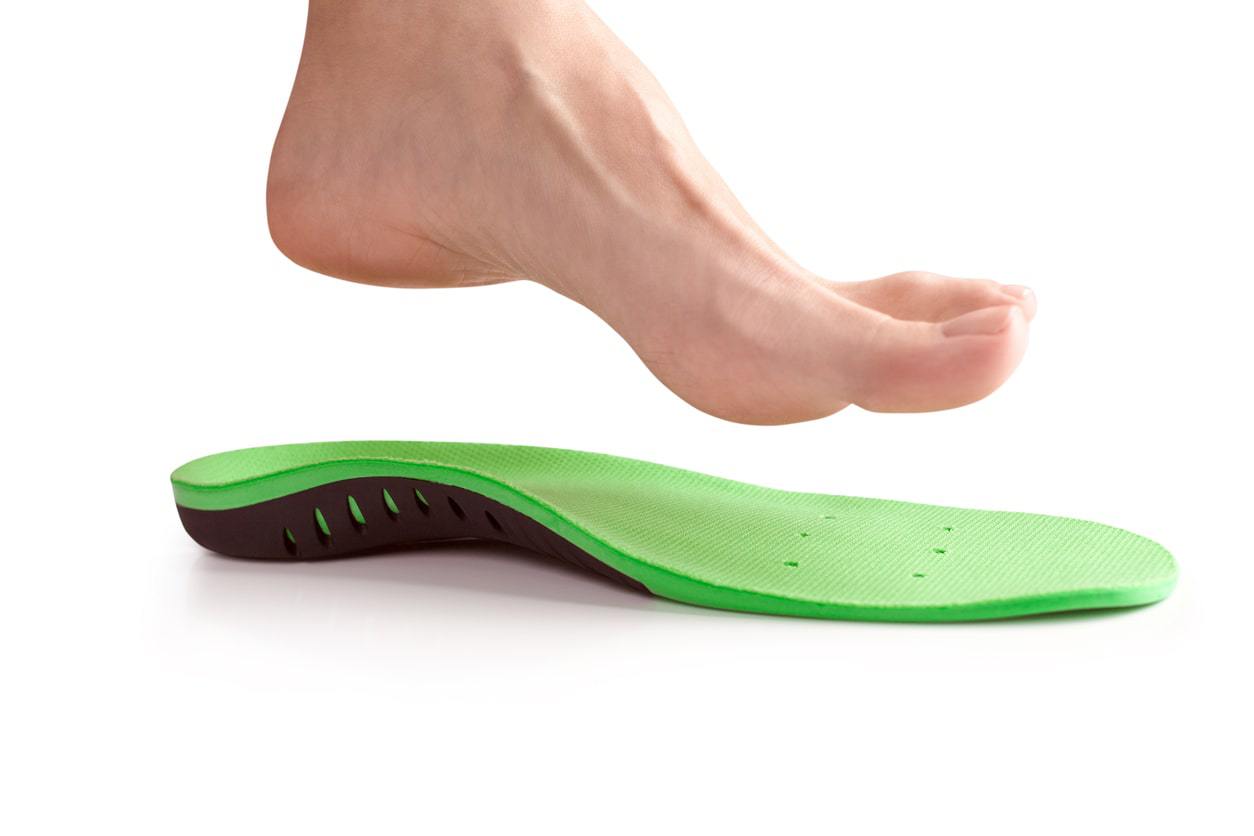
If you don’t want to invest in expensive diabetic footwear or if you already have shoes you feel comfortable in, diabetic insoles and shoe inserts for neuropathy are diabetic foot care accessories that bring additional comfort and protection. They provide improved arch support, shock absorption, impact reduction, foot stability, pain-relief, and anti-fatigue cushioning.
8. Cloud Massage electric foot massager
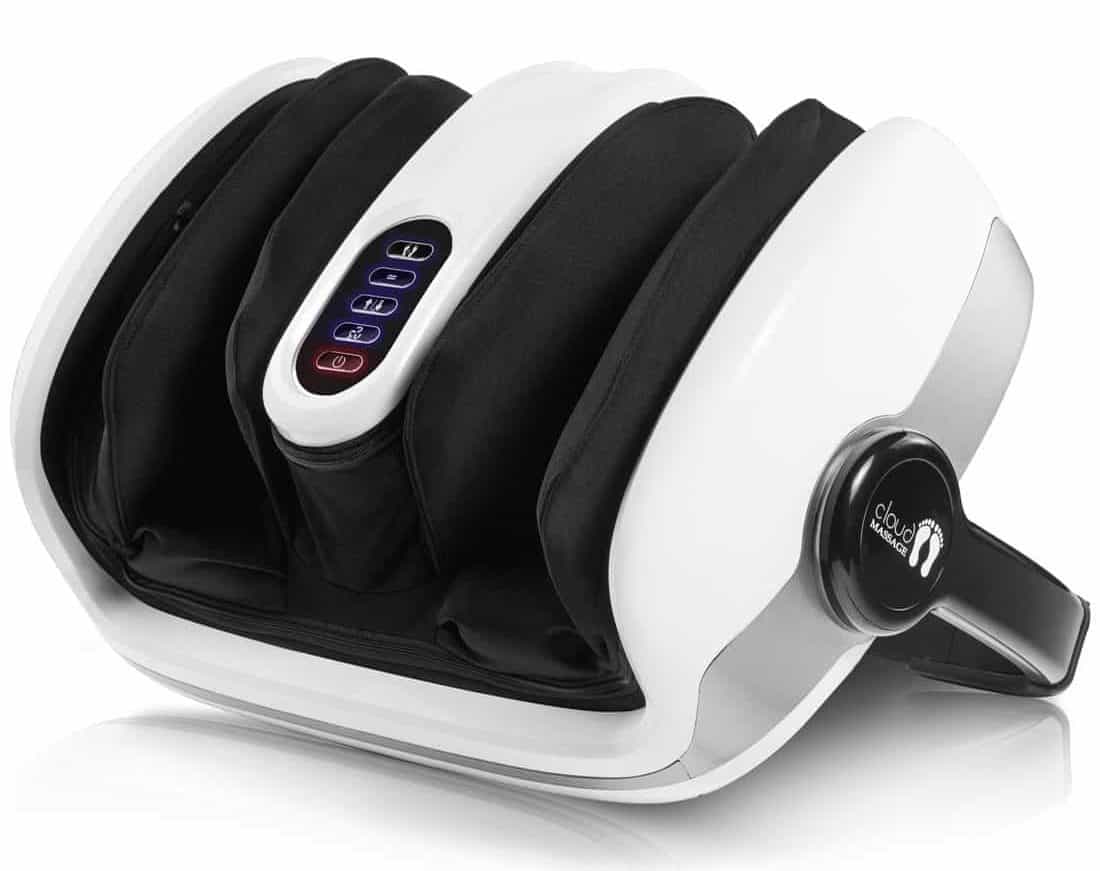
Massaging your feet can help with neuropathy and diabetic foot pain. Not only does it relieve the pain and symptoms, but it also stimulates blood flow and reduces numbness while helping prevent further complications. Electric foot massagers with air compression and heat therapy make great diabetic foot care products to use at home. Cloud Massage’s Shiatsu foot & calf massager is by far the best one, but you can find other ones in this list of best foot massagers for diabetes & neuropathy.
9. Revitive Medic foot circulation booster
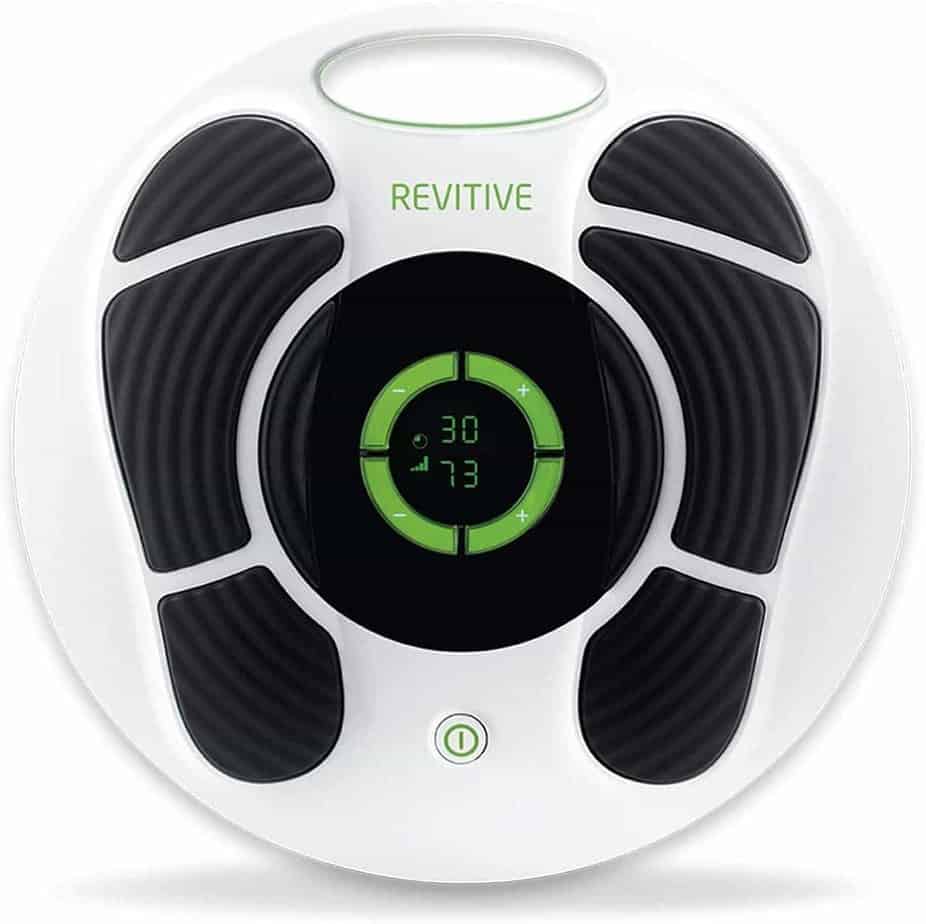
Another great diabetes foot care product to have at home is a circulation booster, especially if you’ve been diagnosed with peripheral artery disease. Stimulating blood flow plays both a preventive and a relieving part for diabetic foot pain. There are dozens of foot stimulators on the market. However, Revitive Medic is the only one that’s officially “FDA-cleared to improve circulation for people with conditions or diseases associated with poor circulation” and meets requirements for FSA/HSA reimbursement. Plus, there’s a 60-days home with a money-back guarantee and a 2-years warranty.
10. iReliev TENS Unit for foot pain

Transcutaneous electrical nerve stimulation (TENS) is a pain management therapy used by millions of chronic pain sufferers who don’t find relief in pharmacological treatments. It blocks the nerves’ pain signal transmission and stimulates the production of endorphins. Many people suffering from diabetic foot pain, neuropathy pain, and plantar fasciitis have turned to TENS devices and are highly satisfied with the relief they’ve found. With its wireless design and a wide range of settings and intensity levels, iReliev is the TENS unit most adapted for foot pain caused by diabetic peripheral neuropathy.
Related article: The 5 Best TENS Units for foot pain in 2022
11. Essential oils for diabetic foot care

Essential oils and aromatherapy have been used for centuries to treat any kind of pain, including chronic nerve pain caused by diabetic neuropathy. They’re potent but natural, have rare side effects, and they’re sold over-the-counter. Some of the best essential oils for neuropathy are Peppermint, Helichrysum Italicum, Frankincense, Myrrh, Basil, and Chamomille. Some oils considerably help reduce nerve pain while others help regenerate damaged nerves, decrease swelling, or improve overall feet health.
12. NatraCure cold therapy socks

Nerve pain caused by diabetes is very different from one person to the other. While some people find relief in heat therapy, others find cold to be more efficient. Cold is a natural analgesic that neutralizes the sensation of pain. Cryotherapy socks are easy to use and have proven to help with neuropathic pain, swelling, burning feet, and other types of foot pain. NatraCure’s cold therapy socks are a best-seller and come at a great price!